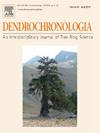基础面积增量的增长趋势:潜在问题、研究结果和最佳实践
IF 2.7
3区 农林科学
Q1 FORESTRY
引用次数: 0
摘要
人们普遍认识到,树木年轮宽度的时间序列必须去趋势化,即在进行任何气候增长分析之前,必须去除与年龄或大小有关的趋势。然而,与环宽(RW)分析相比,关于如何使用基底面积增量(BAI)尚无最佳实践规则。BAI作为林业研究中的一个重要变量,在树木年代学中也得到了越来越多的应用。BAI被认为比RW更能代表树木的整体生长,而且它受年龄趋势的影响也比RW小。在本文中,我们通过调查文献中围绕BAI使用的常见修辞,并通过突出可能存在的问题和明显误解的后果来提供指导。我们对2018-2023年期间的文献进行了回顾,分析中是否考虑了BAI时间序列的年龄趋势。我们还使用Klesse等人(2018)发布的树木年轮数据集进行了额外分析,以调查BAI或RW时间序列是否表现出更强的趋势。文献综述和数据分析都没有支持经常使用的说法,即BAI时间序列具有较小的年龄趋势,这将排除去趋势。事实上,在58 %的调查时间序列中,当树木年龄小于50岁时,BAI的年龄趋势强于RW,甚至在51至100岁之间,我们发现44 %的病例BAI的趋势更强。我们还概述了计算BAI的三种一般方法及其优缺点。我们讨论了当髓距偏移估计(POE)和胸围高度直径(DBH)可用或缺失时,由内到外方法、由外到内方法或Bakker(2005)方法是否有助于将RW转换为BAI。最后,我们建议使用Bakker方法基于POE和DBH信息计算BAI。此外,使用BAI进行的分析应始终考虑每棵树的大小或年龄,特别是在比较不同年龄类别的树的趋势或增长率时。对于气候增长分析,BAI的趋势总是必要的。通过解决这些关键问题,我们的目标是提高基于人工智能的树木年代学和气候生长研究的可靠性和一致性。本文章由计算机程序翻译,如有差异,请以英文原文为准。
Growth trends in basal area increments: The underlying problem, consequences for research and best practices
It is generally recognized that time series of tree-ring widths must be detrended, i.e. the age- or size-related trend must be removed before any climate-growth analysis can be performed. However, in contrast to ring-width (RW) analyses, there are no best practice rules on how to use basal area increment (BAI). BAI as an important variable in forestry has become also an increasingly used variable in dendrochronology. BAI is considered a better representative of the overall tree growth than RW and it is supposedly less affected by age trends than RW.
In this paper, we provide guidance by investigating the common rhetoric surrounding the use of BAI in the literature, and by highlighting possible problems and consequences from apparent misconceptions. We performed a literature review for the period 2018–2023, whether age trends in BAI time series are considered in the analysis. We also conducted additional analyses with a published tree-ring dataset of Klesse et al. (2018) to investigate whether BAI or RW time series exhibit stronger trends. Both the literature review and the data analysis provide no support for the frequently used claim that BAI time series have smaller age trends which would preclude detrending. In fact, in 58 % of the investigated time series, age trends in BAI are stronger than in RW when the trees are younger than 50 years old, and even between the ages of 51 and 100 years, we found stronger trends in BAI in 44 % of the cases. We also provide an overview of three general methods for calculating the BAI together with their advantages and disadvantages. We discuss whether the inside-out method, the outside-in method, or the Bakker (2005) method are useful to convert RW to BAI when the pith offset estimate (POE) and the diameter at breast height (DBH) are available or missing, respectively. We conclude with a general recommendation to calculate BAI based on both POE and DBH information using the Bakker method. Further, analyses with BAI should always consider the size or age of each tree, especially when trends or growth rates are compared for trees of different age classes. For climate-growth analyses, the detrending of BAI is always necessary. By addressing these key issues, we aim to improve the reliability and consistency of BAI-based studies in dendrochronology and climate-growth research.
求助全文
通过发布文献求助,成功后即可免费获取论文全文。
去求助
来源期刊

Dendrochronologia
FORESTRY-GEOGRAPHY, PHYSICAL
CiteScore
5.50
自引率
13.30%
发文量
82
审稿时长
22.8 weeks
期刊介绍:
Dendrochronologia is a peer-reviewed international scholarly journal that presents high-quality research related to growth rings of woody plants, i.e., trees and shrubs, and the application of tree-ring studies.
The areas covered by the journal include, but are not limited to:
Archaeology
Botany
Climatology
Ecology
Forestry
Geology
Hydrology
Original research articles, reviews, communications, technical notes and personal notes are considered for publication.
 求助内容:
求助内容: 应助结果提醒方式:
应助结果提醒方式:


